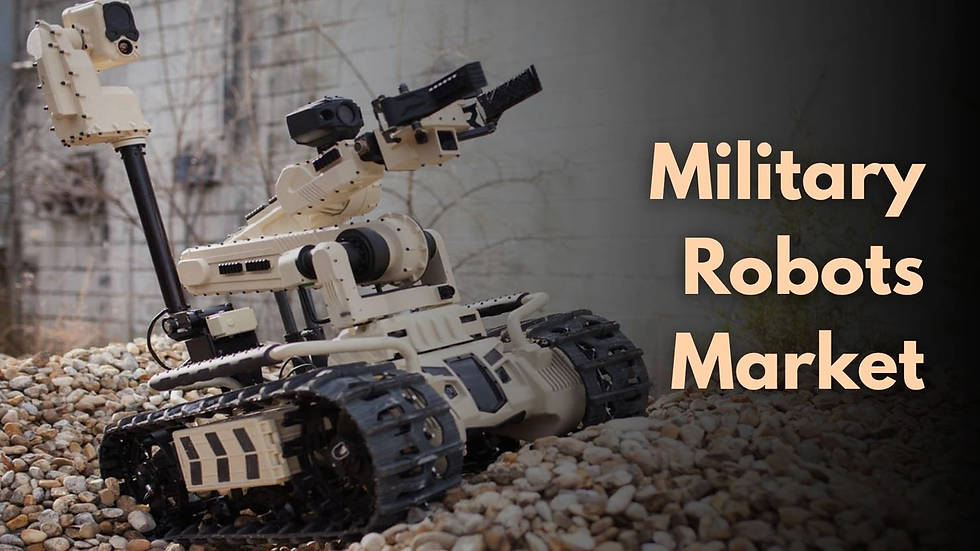Military Robots Market Insights, Trends, Forecast, Size and Share, 2020–2032
- Rishika Chavan
- Aug 4
- 3 min read
According to Fortune Business Insights™, the global military robots market size was valued at USD 13.87 billion in 2019 and is projected to grow from USD 13.03 billion in 2020 to USD 64.13 billion by 2032, exhibiting a CAGR of 12.50% during the forecast period (2020–2032). Europe dominated the global market in 2019, accounting for a 33.74% share, driven by technological superiority and the strong presence of robotics manufacturing firms.
The adoption of advanced aerial, land, and naval robots for tactical military operations—including surveillance, combat support, and search and rescue—is significantly accelerating market growth. Major global powers such as the U.S., China, and Russia are prioritizing the integration of AI-enabled unmanned systems to enhance battlefield decision-making and reduce human risk.

Key Industry Players
Prominent companies operating in the global military robots market include:
Northrop Grumman Corporation (U.S.)
Thales Group (France)
FLIR Systems, Inc. (U.S.)
Clearpath Robotics Inc. (Canada)
Cobham Limited (U.K.)
QinetiQ (U.K.)
AeroVironment, Inc. (U.S.)
BAE Systems (U.K.)
Elbit Systems Ltd. (Israel)
Raytheon Technologies (U.S.)
These companies are focusing on strategic collaborations, technology integration, and R&D investments to maintain a competitive edge in this evolving market.
Source:
Key Market Drivers
Integration of AI and Emerging Technologies in Defense Robotics
The integration of cutting-edge technologies like artificial intelligence (AI), 3D imaging, fiber optics, and IoT has transformed military operations. AI-enabled military robots can identify potential threats, conduct reconnaissance missions, and deliver precision targeting—all without endangering soldiers. This shift is redefining modern warfare by increasing operational efficiency and situational awareness.
Restraints
High Initial Costs and Technological Limitations
Despite their benefits, military robots involve substantial procurement and programming costs, limiting their adoption by smaller defense organizations. Additionally, as many robots follow pre-programmed patterns, they can become vulnerable to enemy countermeasures, posing a challenge to sustained operational efficiency.
Market Segmentation Overview
By Platform:Land-based robots are anticipated to experience substantial growth throughout the forecast period, driven by increasing investments in ground-based defense robotics and the rising demand for border surveillance, particularly across Asia. These robots are increasingly being utilized in tactical missions, logistics, and explosive ordnance disposal. Meanwhile, airborne platforms—such as drones equipped with missiles and reconnaissance systems—are gaining momentum due to their capabilities in high-risk offensive operations and real-time battlefield monitoring. Naval robots are also emerging as a critical asset in defense operations, particularly for underwater surveillance, mine detection, and anti-submarine warfare, further contributing to market expansion.
By Mode of Operation:Autonomous military robots are projected to grow at a higher pace owing to their ability to execute missions independently using technologies like artificial intelligence (AI), light detection and ranging (LiDAR), 3D imaging, and advanced sensor networks. These systems enhance operational flexibility, reduce human involvement, and provide strategic advantages in intelligence gathering and combat operations. Semi-autonomous robots, however, remain crucial in legacy defense systems where human supervision and intervention are still necessary, especially for complex or unpredictable mission scenarios.
By Mode of Propulsion:Manual robots held the largest market share in 2019, as they are extensively used for long-range missions powered by traditional engines, thrusters, and GPS-based navigation systems. These robots are typically command-controlled and serve ground operations effectively. However, the demand for electric-propelled robots is accelerating, particularly in aerial and naval applications, due to their advantages such as low noise emissions, energy efficiency, and adaptability to stealth operations. Hybrid propulsion systems are also gaining traction in specialized mission environments.
By Application:The Intelligence, Surveillance, and Reconnaissance (ISR) segment dominated the market in 2019 and is expected to retain its leading position over the forecast period. The dominance is attributed to the rising deployment of unmanned aerial vehicles (UAVs), unmanned ground vehicles (UGVs), unmanned surface vehicles (USVs), and autonomous underwater vehicles (AUVs) across multiple defense operations. These platforms enhance situational awareness, enable data-driven decision-making, and provide real-time tracking of enemy movements. In addition to ISR, other applications such as search and rescue, combat support, and transportation are witnessing increased demand due to their essential roles in tactical logistics, frontline support, and mission-specific deployments.
Regional Insights
Europe
Europe led the market in 2019 with a size of USD 4.68 billion. The region is home to over 300 service robot manufacturers, excelling in navigation, haptics, and motion planning technologies. However, post-COVID-19 defense restructuring could temporarily restrain short-term growth.
Asia Pacific
Asia Pacific is projected to grow exponentially, driven by China and India’s investments in robotics and defense modernization programs. The focus on AI and autonomous systems is expected to reshape the regional military robotics landscape.
North America
North America is anticipated to show strong growth during the forecast period due to government-backed R&D investments, a robust supplier network, and advancements in robotics and electronics technologies.
Middle East & Africa, Latin America
These regions are expected to experience steady growth as governments increasingly invest in modernizing defense forces and adopting unmanned and autonomous systems.
Key Industry Developments
November 2020 – Tyndall Air Force Base, USA, became the first to deploy semi-autonomous robotic dogs for patrolling, enhancing situational awareness and reducing manpower risk.
September 2020 – AeroVironment, Inc. signed a partnership with Robotic Skies to deliver maintenance and repair support services, boosting after-sales performance and reliability.



Comments